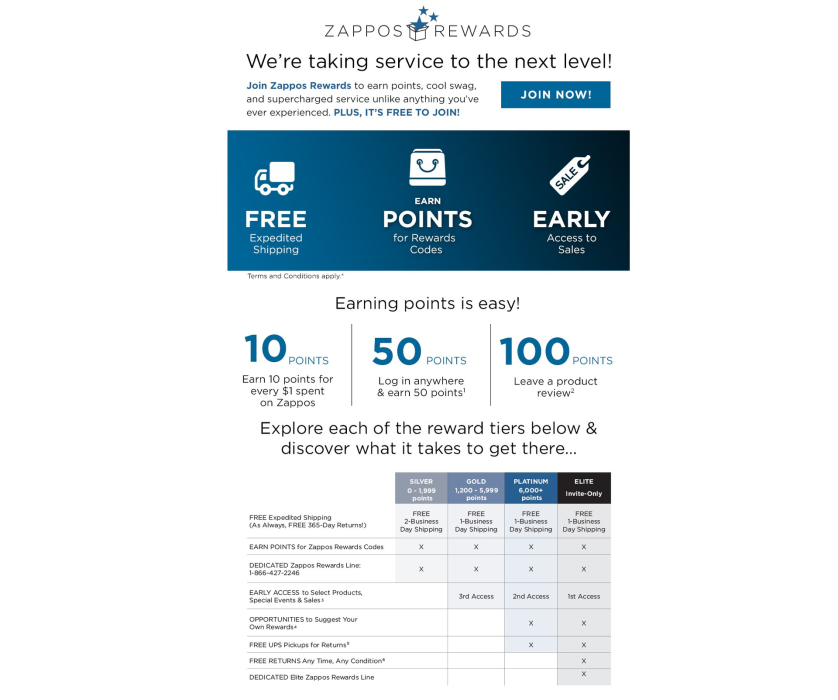For many brands, loyalty programs are a one-size-fits all concept: The more you buy, the more rewards you receive. Not for Zappos. The shoe and clothing retailer designed its four-tiered program, Zappos Rewards, based on customers’ shopping and engagement behaviors to incentivize different segments to interact with the brand on a regular basis.
Zappos announced the launch of its first loyalty program on September 28th, but the brand’s director of marketing, Kedar Deshpande, says that the brand had been working on the program for the past few months. The motivation behind launching the program, he says, was to extend the high-quality customer experience of contacting its call center to the online realm.
“We always have a great customer experience with customers contacting the call center,” he says, “but we could not scale that regular customer experience to our website customers, particularly when they interact with us.”
Rather than create one “cash-back” rewards program for everybody, Deshpande and his team wanted to produce a four-tiered rewards program that offered different value propositions to different customer segments.
The tiers are based on points and a broken down as follows: Silver (zero to 1,199 points), Gold (1,200 to 5,999 points), and Platinum (6,000 or more points). There’s also an Elite tier for highly engaged Zappos members, which is invite only. Customers can ascend from one tier to the next by performing specific activities. Participants earn 10 points for every dollar spent, 50 points for logging in, and 100 points for leaving a review. While there’s no limit on how many points customers can earn by making qualifying purchases, there is a 250,000 point maximum on the number of points customers can earn per calendar year by logging in and writing reviews. Also, customers receive points for only one log-in per day.
Every time customers achieve a different tier status they earn access to different rewards. According to Deshpande, these reward tiers were based on Zappos’ customer shopping and engagement data and were designed to offer the most relevant rewards to each segment.
For example, Platinum and Elite members have access to free UPS pickups for returns; Silver and Gold members do not. Deshpande says this is because the former tier members make more purchases, and therefore make more returns, than the latter two.
But Zappos’ customers aren’t the only ones benefitting from the program. The brand’s marketers are, too. By having members perform certain activities, Zappos is able to gain insights about its customers and deliver optimized experiences—increasing its chances of getting those customers to return. By having a customer log in with an email address, for example, Zappos is able to identify that customer and create a more tailored experience. This can especially come in handy when more than one shopper uses the same device, like when a mother and daughter use the same desktop, Deshpande explains.
“If I know [who] the customer is I can sell better products to them, [and] I can sell better recommendations to them,” he says.
Customers can sign up for the program by creating a Zappos account and opting in online or by emailing, chatting, or calling the brand’s customer service team. According to Deshpande, Zappos’ marketers have been encouraging people to sign up through email and social media. It’s also running a promotion through the end of the month in which existing Zappos customers can earn a $15 rewards code for signing up. In addition, Zappos surprised 1,000 randomly selected customers by sending them an item on their wishlists.
As the promotions may suggest, this program currently targets existing Zappos customers; however, Deshpande says the brand will expand its reach to new customers in the upcoming months. He also says that Zappos will measure the success of the program primarily through customer satisfaction and engagement metrics, like customers’ interaction and use of the program.
“We don’t want to create a gym membership program where customers sign up and don’t show up,” Deshpande says. “We want to make sure that our program drives customers back regularly. That utilization is [how] we’re going to measure the success of the program.”
And while it’s still early days, initial results suggest that Zappos is meeting its goals. Deshpande says that Zappos had 60,000 to 70,000 people sign up within the first two days. And at the time of this late September interview, he said that there were customers who had been logging in every day and that customers were generating “more reviews at a much larger rate than we ever anticipated.”
Of course, this road to success hasn’t been without a few bumps. Deshpande says the biggest challenge was initially building a flexible rewards program that would allow him to add different value propositions in the future—a “nightmare” for marketers locked into traditional rewards program.
Clearly, the company is willing to put its best foot forward to deliver optimum experiences for its customers.








